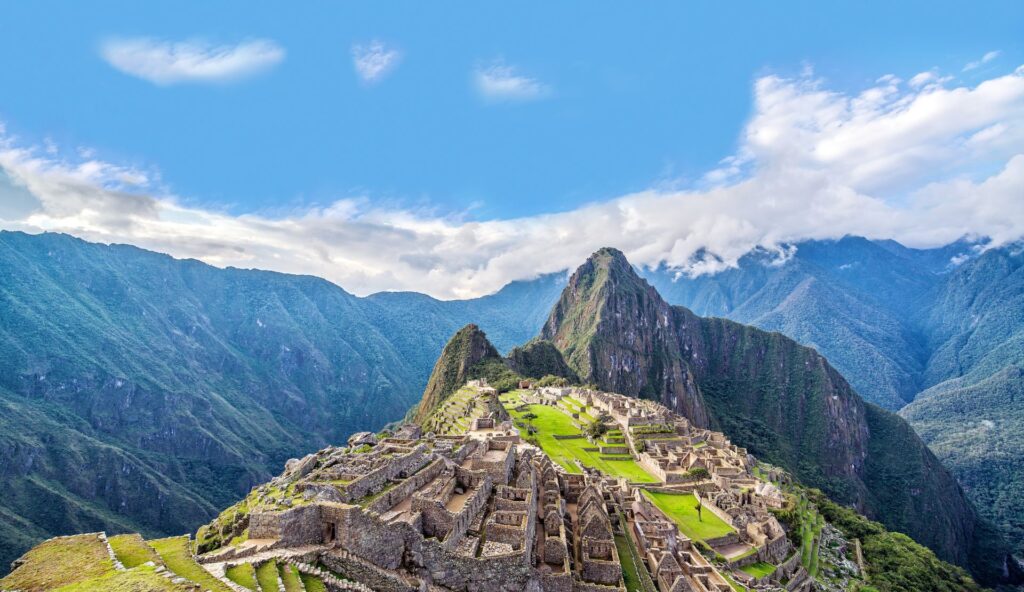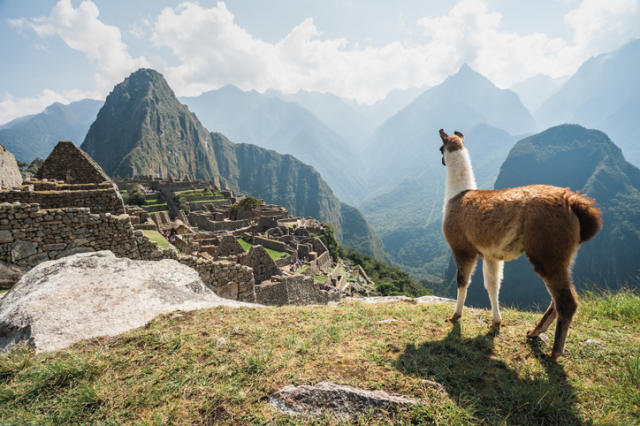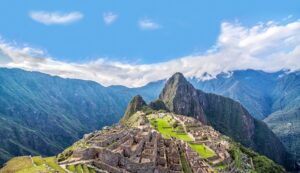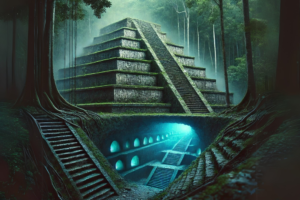Machu Picchu is an ancient Incan citadel located in the Andes Mountains of Peru. The site is believed to have been built in the 15th century and was abandoned less than 100 years later at the time of the Spanish conquest. Despite its brief history, Machu Picchu is considered one of the most important archaeological sites in South America and is a UNESCO World Heritage Site. The site is situated on a mountain ridge above the Urubamba River and is made up of over 150 buildings, including temples, residences, and storage facilities. The site is also known for its intricate terracing and irrigation systems, which were used to cultivate crops in the surrounding area.
Machu Picchu is accessible by train from Cusco, the former capital of the Incan Empire, or by hiking the Inca Trail, a popular trek that passes through several Incan ruins before reaching Machu Picchu. The site receives over 1 million visitors annually and has become one of the most popular tourist destinations in South America.
It is considered one of the most remarkable architectural and engineering feats of the Inca civilization and also a symbol of the Andean culture . The citadel is a testimony to the Andean people’s knowledge of architecture, engineering and mathematics.
Due to its popularity, the Peruvian government has implemented regulations to limit the number of daily visitors to the site, so it is important to plan ahead if you want to visit Machu Picchu.
Machu Picchu’s purpose and exact origins remain a mystery, but it is believed to have been a royal estate or a sacred religious site. Some experts believe that it was a spiritual retreat for the Inca elite, while others believe that it served as a kind of agricultural laboratory, where Inca engineers tested different crops and terracing methods.
The layout of Machu Picchu is divided into two main sections: the agricultural sector, located to the south and west of the main plaza, and the urban sector, located to the north and east of the main plaza. The agricultural sector is characterized by its terraces, which were used for crop cultivation, as well as by its irrigation canals and fountains. The urban sector, on the other hand, is characterized by its houses, temples, and other buildings.
The most important temples in Machu Picchu are the Temple of the Sun and the Temple of the Three Windows. The Temple of the Sun is a semi-circular building located on the highest point of the citadel, while the Temple of the Three Windows is located on the eastern side of the main plaza and is believed to have been used for astronomical observations.
One of the most iconic features of Machu Picchu is the Intihuatana, a stone structure that was used for astronomical observations. It is said that during the winter solstice, the sun would shine directly through a window onto the stone, marking the shortest day of the year.
Machu Picchu is considered a masterpiece of engineering, as the Incas were able to construct such an impressive citadel in such a remote location using only the most basic tools and without the use of the wheel. The site is a testament to the ingenuity and skill of the Incas, and continues to fascinate visitors from all over the world.


It should be mentioned that Machu Picchu is not the only Incan ruin in the area, other important sites such as Huyana Picchu, Temple of the Moon, and Inca Bridge are also found around Machu Picchu. These sites offer visitors a glimpse into the rich history and culture of the Inca people and are also worth visiting.
In addition to its architectural and engineering achievements, Machu Picchu also holds great cultural and spiritual significance for the descendants of the Incas, as well as for many modern-day Peruvians. Many of the site’s buildings, such as the Temple of the Sun and the Temple of the Three Windows, are believed to have been used for religious and spiritual ceremonies.
The Incas had a complex religion that revolved around the worship of natural elements such as the sun, moon, and stars, as well as of their ancestors. Machu Picchu is believed to have played a central role in this religion, and many of its buildings are thought to have been used for ritual practices.
Machu Picchu was rediscovered in 1911 by the American explorer Hiram Bingham, who brought the site to the attention of the world. Since then, it has become one of the most popular tourist destinations in South America, attracting thousands of visitors from all over the world every year.
It is also mandatory to hire a guide to visit Machu Picchu. This is done to ensure that the site is preserved for future generations, and also to make sure that visitors have a safe and enjoyable experience.
In recent years, the Peruvian government has taken steps to improve the infrastructure at Machu Picchu in order to make it more accessible to visitors. This includes the construction of new facilities such as restrooms and visitor centers, as well as the upgrading of existing facilities such as the Machu Picchu train station.
Machu Picchu is a truly unique and breathtaking site that offers visitors a glimpse into the rich history and culture of the Incas.
Another important aspect to consider when visiting Machu Picchu is the impact of tourism on the site. With over 1 million visitors annually, the site is under a lot of pressure and it is important to be aware of the impact that tourism can have on the preservation of the site.
The Peruvian government, in partnership with UNESCO and other organizations, has implemented various measures to reduce the impact of tourism on the site. This includes limiting the number of daily visitors, implementing strict regulations on the use of cameras and flash photography, and promoting responsible tourism practices such as not climbing on the ruins or taking souvenirs from the site.
In addition, there are also initiatives to promote sustainable tourism in the surrounding area, such as promoting alternative routes like Salkantay trek, Lares trek, Choquequirao trek, and others, which can benefit the local communities and help to reduce the pressure on the site.
Another way to help preserve the site is by supporting local businesses and communities. Many of the local communities in the area rely on tourism as a source of income and by supporting them, visitors can help to ensure that the site is preserved for future generations. This can be done by staying in locally-owned accommodations, buying locally-made crafts, and supporting community development projects.
It’s also important to note that there are many other sites in the area that are worth visiting, such as the Sacred Valley of the Incas, which is home to many other Incan ruins, and is also an area of great cultural and historical significance.
In conclusion, Machu Picchu is a unique and fascinating site that offers visitors a glimpse into the rich history and culture of the Incas. However, it is also important to be aware of the impact of tourism on the site and to take steps to preserve it for future generations. By following responsible tourism practices and supporting local communities, visitors can help to ensure that this unique and precious site is preserved for future generations to enjoy.



